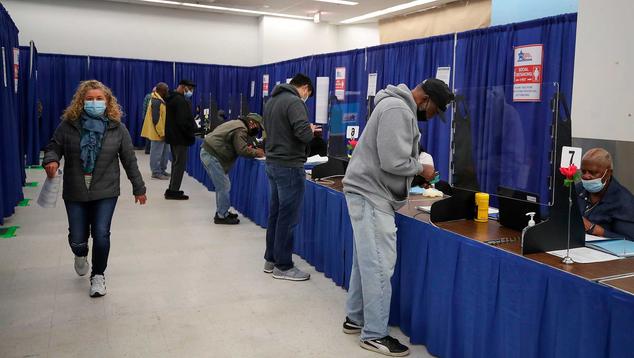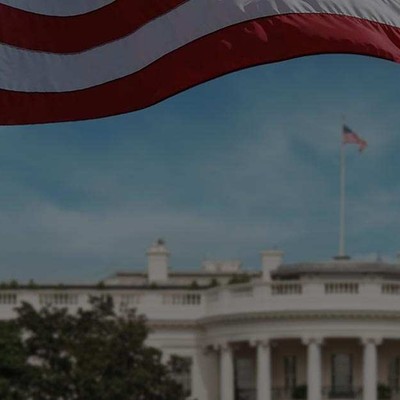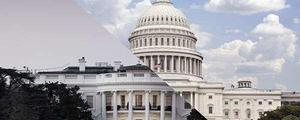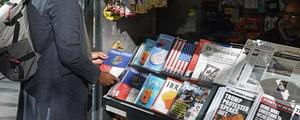Story Highlights
- Americans giving similar thought to presidential election as in 2012, 2016
- Republicans and Democrats closely matched on thought given to election
- Enthusiasm about voting high among partisans, but not independents
WASHINGTON, D.C. -- Americans' attentiveness to the presidential election continues to increase as the campaign enters its final month. Seventy-four percent of U.S. adults now say they are giving the election "quite a lot" of thought. This is up slightly from 71% before the start of the national party conventions in August and 59% in April when the country was in the grip of the first wave of coronavirus infections.

Line graph. Americans' attention to the 2020 Election is rising as the election nears. The percentage of Americans who say they are giving "quite a lot of thought" to the 2020 Election has risen from 59% in April to 74% in September.
Americans' attention to the election in Gallup's Sept. 14-28 poll is not remarkable from a historical perspective. It is consistent with mid-September Gallup readings from the last two presidential election years (72% in 2016 and 73% in 2012), while lower than the 80% found at the same point in 2008 and 77% in 2004. Americans were far less attentive to elections before 2004.
The disputed outcome of the 2000 U.S. presidential election may be a factor in this, as evidenced by the much higher proportion of Americans since 2004 saying the outcome of presidential elections matters more to them than in the past. Intensified public policy concerns after 9/11, as well as Americans' increased use of cable news, the internet and social media, may also be factors.

Line graph. The percentages of Americans giving the election "quite a lot" of thought during Septembers prior to presidential elections since 1992. Currently, 74% of Americans are giving the election quite a lot of thought, essentially the same as the 72% who said the same at this time in 2016.
Gallup's "thought given to the election" question has been strongly related to voter turnout in past presidential elections. Thus, the current finding is signaling that turnout of the voting-age population is on track to be similar to that in the 2012 and 2016 elections, which was in the 55% to 56% range.
Voter turnout was higher -- about 58% -- in 2008, when 80% of Americans in September and 81% just before the election were giving the campaign quite a lot of thought. Turnout was also on the high side -- close to 57% -- in 2004, when the final "thought given" reading was 84%. Turnout was markedly lower in 2000 (51%), when 70% of Americans reported giving the election a lot of thought.
Thought typically increases in the final month before the election, although whether that plays out this year given that early voting will be starting earlier than ever remains to be seen.
Turnout Among Independents Could Be Lower
Republicans (83%) and Democrats (81%) are about equally likely to say they are giving quite a lot of thought to the election, with independents lagging at 64%. This is similar to the partisan pattern seen at this stage of the campaign in all election years since 2000. As more people focus on the campaign in the final month, larger gaps between Republicans and Democrats can emerge.
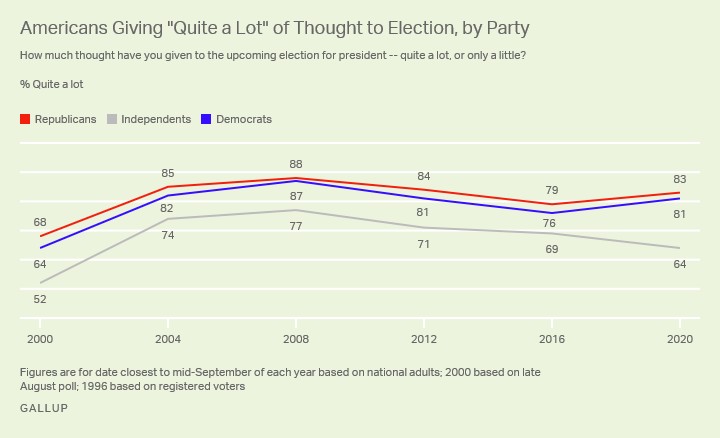
Line graph. The percentage of Americans giving "quite a lot" of thought to the election, by party affiliation. 83% of Republicans, 81% of Democrats and 64% say they are giving quite a lot of thought the upcoming election.
Enthusiasm About Voting Relatively High
Americans are expressing greater enthusiasm about voting in the 2020 election than they have done at a similar point in any election year since 2004. In fact, the 67% currently saying they are more enthusiastic than usual about voting ties as the highest Gallup has measured at any point in prior campaigns, including a late October 2008 reading and a reading right after the 2004 Democratic convention.
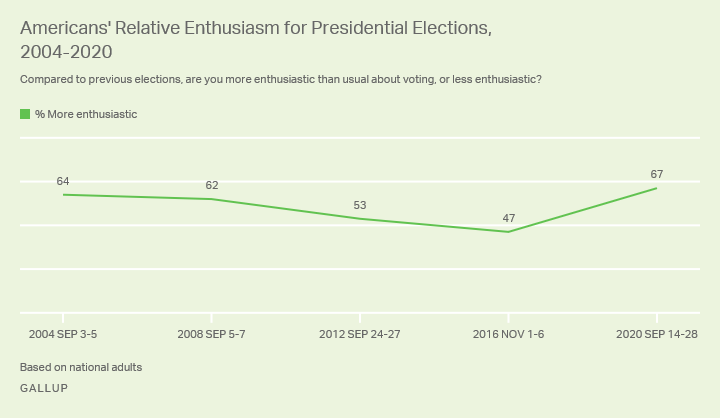
Line graph. Americans' relative enthusiasm for presidential elections from 2000-2020. 67% of Americans say they are now more enthusiastic to vote in the 2020 election than they usually are, up from 47% who said the same in 2016.
Enthusiasm about voting has increased substantially among both major party groups since 2016, with 80% of Democrats and 75% Republicans saying they are more enthusiastic than usual about voting this year.
In fact, both party groups are more enthusiastic than they have been in any of the past four elections, although Republicans' enthusiasm is similar to that recorded in September 2004 while Democrats' exceeds the previous high (68% in 2008) by 12 percentage points.
Echoing the lower percentage of independents than partisans giving a lot of thought to the campaign, independents lag partisans by more than 20 points in enthusiasm about voting this year. That is the largest enthusiasm gap between independents and partisans that Gallup has recorded at this stage of a presidential campaign in the past five elections.

Line graph. The percentages of Americans who say they are "more enthusiastic" than usual about voting in the upcoming presidential election from 2004 -2020, by political affiliation. 80% of Democrats say they are more enthusiastic about voting, up from 54% in 2016. 75% of Republicans report they are more enthusiastic, up from 52% in the previous presidential election. And 54% of independents report greater levels of enthusiasm, compared with 39% in 2016.
Gallup's enthusiasm measure has not been a strong predictor of turnout, historically, but it may relate to how positively Republicans and Democrats feel about their respective candidates, including their chance of winning.
Bottom Line
Gallup's long-used "thought given to the election" question suggests that 2020 will be a fairly typical year in overall turnout (around 55%, where it was in 2012 and 2016) if Americans' level of election attention continues to increase over the next month, as it normally would. That is also assuming voters -- particularly Republicans, who as of now are far more likely than Democrats to plan on voting in person -- ultimately activate on their propensity to vote.
Learn more about how the Gallup Poll Social Series works.
